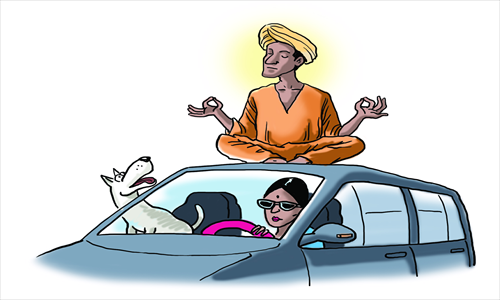Indian gaiety at odds with Chinese rush

We were heading toward the home of a middle class family living in East End Apartments, Delhi. The taxi navigated through the night, and the surroundings appeared increasingly run-down. Looking out of the window, there were fewer cars and more rickshaws on the road.
A murmur of doubt rippled among my companions on the back seat: "Are we going the wrong way?" In Beijing, a middle class family, even residing far from the center of town, is usually living in a well-furnished block of flats.
The Indian family we were visiting included journalists, artists, engineers and architects. They also warmly invited their neighbors to meet and talk with us. It was a community of intellectuals, and the women all had decent jobs. Until the moment we stood up to say good-bye, we still couldn't believe that the material standards of these Indian middle-class families fell so far below our expectations.
That night passed with authentic Indian food and pleasant conversation. Besides introducing us to the gods on their altar and the tense cricket match between India and Pakistan on TV that evening, they talked of social problems, such as inadequate social welfare for the elderly and soaring house prices in Delhi. To us, it was astonishing that no one was complaining amid the conversations.
Certainly, Indians are not necessarily satisfied with their life, but they do have a more peaceful and satisfied state of mind, which is in sharp contrast with the anxious, testy Chinese.
While flying between Indian cities in October, I was reading India: A Million Mutinies Now by writer V.S. Naipaul. In his incisive observation, India, struggling between tradition and development, is undergoing slow, hidden changes in every social aspect - views about marriage, family, religion and caste.
These traditional views are still functioning in India, although the caste system is illegal, which partly explains why people are able to acquire a mentality of peace while exposed to social shake-ups incurred by modernization.
Before going to India, I heard a story from a friend, saying that he had dinner at the house of a rich Indian businessman, whose servants kneeled beside the table reverently throughout the meal. The friend talked to a servant, asking his plan for the future, only to learn his high appreciation of his employer and the gods.
The story was probably exaggerated. But such attitudes do exist. Compared with their Chinese counterparts, Indians better understand being content with their lot, and tend to have less appeals about their interests and rights.
It's hard to tell whether the pros outweigh the cons in this regard. On the one hand, the mentality helps placate the public and facilitate social stability.
Take traffic as a simple example. In the streets of Delhi, vehicles of all sizes and shapes crowd together. People are everywhere, waiting for a bus or a ride by motorcycle. They file onto buses whose doors never close, or sit on overloaded motorcycles. Cars are lined up in traffic jams, but endless drones from the horn are rarely heard.
But on the other hand, the Indian sense of reconciliation and relaxation may clash with or even impede development. Unlike Chinese surrounded by a sense of urgency and ambition, Indians seem less motivated to seize the moment, catch up with successful examples despite wide cleavages, crying out for equality and fairness, and fighting for a better tomorrow.
While some criticize Chinese people who stop at nothing to make money and seek development, many adhere to the Chinese view of efficiency and ambition, which has ensured the country swift and continued growth.
In Africa, some companies have already jumped on the bandwagon of copying the Chinese 24/7 economy. However, it's hard to imagine the Chinese way of development could prevail in India.
The author is an opinion editor with the Global Times. chenchenchen@globaltimes.com.cn